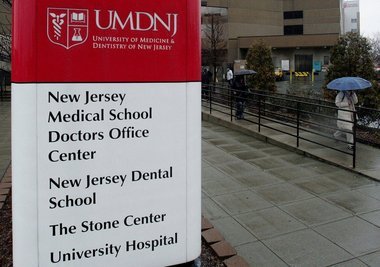 The University of Medicine & Dentistry of New Jersey in Newark in a 2005 file photo.
The University of Medicine & Dentistry of New Jersey in Newark in a 2005 file photo.
By Samuel A. Delgado
With 60,000 students and faculty at six colleges and universities, Newark has the fifth-highest concentration of higher education on the East Coast, after Boston, New York City, Philadelphia and Washington, D.C.
Yet most people in America — let alone New Jersey, and maybe even in Newark — don’t think of the city as a “college town.” In fact, Newark was recently named in the top 10 least desirable college towns in America by the Princeton Review.
With Gov. Chris Christie proposing major changes for University of Medicine and Dentistry of New Jersey and new leadership at Rutgers University-Newark, Essex County College and New Jersey Institute of Technology, Newark has the historic opportunity to rethink how these institutions of higher education can enhance the quality of life for Newark residents and how the city can make life better for college students.
Most importantly, city planners must encourage the development of an identifiable “college center,” with enough student, faculty and retail density to support economic activity at all times of the day and night.
It’s no secret to what makes a great college town. Anyone who has spent time in Chapel Hill, N.C.; Austin, Texas; or Boston knows: It’s a concentrated mix of bookstores, coffee shops, bars, theaters, restaurants with outdoor seating, galleries, quirky retail shops alongside national retailers and plenty of affordable housing for students, professors and recent graduates.
With the recent burst in construction, Newark’s universities off Martin Luther King Jr. Boulevard and the Central Ward are increasingly becoming residential campuses, as more students want the experience of living and studying in a big city.
Rutgers has plans to convert its former law school, at 15 Washington St., into apartments with room for 350 students and visiting faculty. The university also has plans to build undergraduate student housing for 400 students behind that property.
The New Jersey Institute of Technology also has a proposal to build $66 million worth of student housing that will house 600 students. The plan includes a complex of dorms known as Greek Village and a six-story residential honors college.
Even the Newark Housing Authority is getting into the game. In what was once Baxter Terrace, one of the city’s most notorious housing projects, the authority is building a complex with 400 units, steps from NJIT, to be open to graduate students.
Combined with the existing dorms, the additional housing will create a critical mass capable of sustaining businesses, restaurants, offices and institutions geared toward the student population.
Newark’s master plan recognizes the universities as an opportunity for the city to reinvent itself. It notes that the colleges and universities “serve as magnets for young people that have the potential of animating the city’s street life.” But the plan fails to outline any strategy between the city and the colleges to create that identifiable “college center” with a soul.
Now is the time to bring all stakeholders to the table and create a collaborative plan to build the kind of neighborhood that could one day earn Newark recognition as one of American’s top college towns.
The city’s master plan lays out several streets in the University Heights neighborhood that could connect the institutions to the greater community, including Halsey Street, Washington Street, University Avenue and Martin Luther King Jr. Boulevard.
Halsey Street already has several bars and restaurants, a coffee shop and a few funky retailers — all of which serve as a magnet for both students and workers from surrounding businesses. But the street suffers from blighted sites, vast parking lots and boarded-up, decaying buildings that once housed thriving retailers.
Washington Street and University Avenue have the advantage of leading straight to the Broad Street Station, a tremendous link to Manhattan, while MLK Boulevard bisects NJIT, Rutgers and Essex County College.
Whatever streets are chosen for “college-oriented” development is less important than achieving general consensus among the stakeholders that the time to act is now.
Otherwise, Brick City will have squandered a golden opportunity to be a great college town.
Samuel A. Delgado, a Newark resident, is vice president of external affairs at Verizon New Jersey, a director of the Brick City Development Corp. and a member of the Rutgers Business School Board of Advisors.
Related opinion:
• Editorial: Gov. Chris Christie's plan for N.J. higher ed is promising
• Rutgers' urban bias gives Newark campus short shrift
• Don't merge Rutgers-Camden, Rowan University

